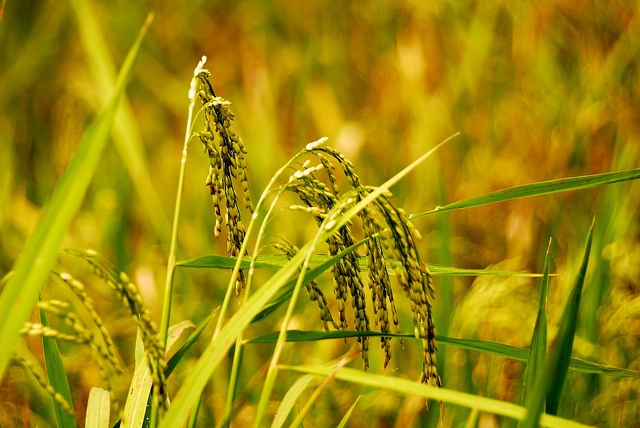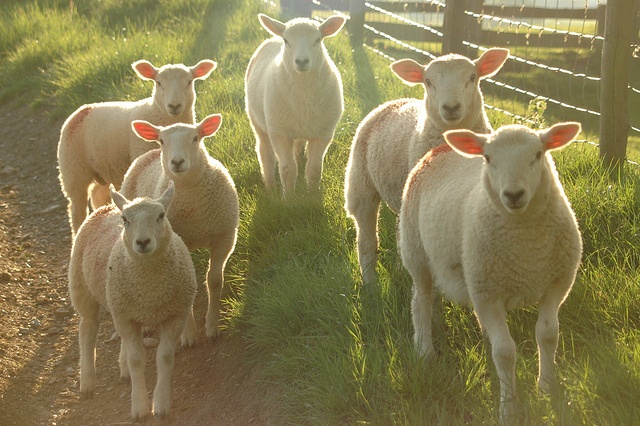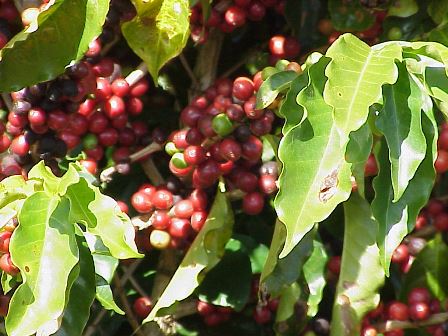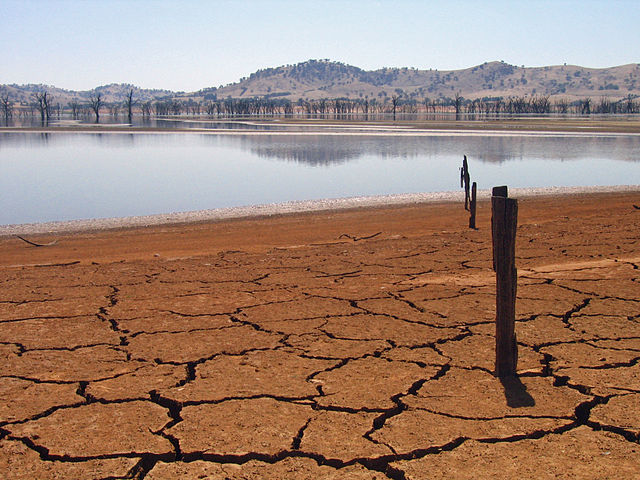Feeding a hot, hungry world
Expert reviewers
Essentials
- Changing climatic conditions are going to affect the world’s agricultural production
- Increased average global temperatures may allow some production of crops in areas that were previously too cold, but this is likely to be outweighed by crop reductions in areas that will become too warm
- Increased CO2 can enhance plant growth in some cases, but this tends to increase only the leafy matter of the plant, not the roots, seeds or fruit which are usually more important food sources
- Livestock may be affected by heat stress and also possible reduction in feed sources
- Marine fisheries may be affected by warmer ocean temperatures and increasing ocean acidification
- An increase in extreme weather events may also compound the other stresses upon agricultural production
In 2010, global agricultural production amounted to more than eight and a half billion tonnes of grains, vegetables, meat and other bio-products. Slightly more than eight billion tonnes (that’s more than eight trillion kilograms!) of this was food. Despite this staggering number, more than 870 million people in the world are still hungry.
Global food producers need to meet the needs of a continually rising world population. Our agricultural systems must become evermore efficient and produce ever increasing amounts. This is a big ask, and the effects of climate change are going to make it tougher. The increased levels of CO2 in the Earth’s atmosphere, produced mainly by the burning of fossil fuels and changes in land use, are predicted to cause higher average temperatures, altered rainfall patterns, and an increase in extreme weather events. Predicting the local environmental conditions within agricultural areas is likely to become more complicated, which will make it harder for farmers to plan for the future.
The complex nature of agricultural systems means there are a number of different variables we must consider when we try to assess how these changes in the Earth’s climate system will affect global food production.
Will plants actually flourish with more carbon dioxide?
During the
photosynthesis
GLOSSARY
photosynthesisThe biochemical process in which green plants (and some microorganisms such as algae) use energy from light to synthesise carbohydrates from carbon dioxide and water. Photosynthesis can be shown as:
CO2 + H2O + energy → [CH2O] + O2
process, plants make their energy to grow by converting CO2 and water to energy, with the help of sunlight. Ignoring the other things (like temperature and water) that limit plant growth, many crops would actually grow better with more CO2 in the atmosphere. However, the ways in which different plant species convert CO2 to energy are different, meaning that while some plants benefit from increased CO2, others do not. Furthermore, ‘real world’ experiments have shown that increased crop yields were not as great as expected from smaller scale greenhouse trials. Additionally, increased CO2 can increase the vegetative matter of a plant, and not necessarily the number or size of the fruits, seeds or roots, which are the parts that people generally rely on for food.

Faster plant growth can also have side effects. Some types of pests and diseases will flourish in the denser, leafier plants. Faster-growing plants often absorb fewer nutrients, such as nitrogen, so the end food product has a lower nutritional value. Additionally, some plants such as cassava, almonds and sorghum (a common cattle feed) produce toxins in their leaves, fruits or roots as a defence against insects and animals. When these plants grow faster, they produce more of these toxins, and less protein. So, not only do the people who rely on these plants end up eating plants with higher levels of toxins, they also have to eat more of them, to get the same amount of protein.
Warmer... warmer... too hot!
A small amount of warming is expected to improve crop yields in the cooler regions of the world. For example, warmer winters will probably result in areas of northern China being able to grow more wheat. However, warming of greater than 3°C will cause a decrease in crop yields as the benefits of slightly increased temperatures turn into heat stress. After the optimum temperature for growth is exceeded in any one place, the decline in crop yields is very steep. Parts of the tropics are expected to suffer from decreased yields even with warming of 1–2°C.
An increase in night time temperatures, where most of the temperature increase caused by climate change is expected to occur, of just 1°C has seen a 10 per cent loss in rice yields.

Furthermore, higher temperatures during particular stages of plant growth, such as the flowering stage, can result in reduced and poor quality yields. Early flowering, triggered by warmer temperatures, can also present a problem. As the fruiting process of many plants relies on bees to pollinate flowers, reductions in yields can occur if bees are still hibernating when the plants flower.
While warmer temperatures can increase the length of the growing season, they will also result in thirstier plants. About 80 per cent of all agricultural land and virtually all pastures rely on rain, and changes to rainfall patterns may mean this rain does not fall as often or as regularly. Too much rain, and excessive soil moisture, can be as detrimental as not enough, so it’s clear that altered rainfall patterns could have serious consequences.
Hot and bothered animals
About one third of the world’s food supply comes from livestock and fisheries. As average temperatures around the world increase, heat stress may affect animals in a number of ways. Dairy cows in particular don’t like to be too hot, and produce significantly less milk when stressed. Cattle may spend more time looking for shade, and so graze less and also have a decreased feed intake. This means they won’t grow as quickly, or may even lose weight, resulting in less meat. Sheep and pigs will suffer similarly, and hens will produce fewer eggs or even stop laying. Extreme heat stress results in increased mortality of the animals.

A decrease in grain production caused by changing climate conditions may lead to feed shortages for livestock. Animals raised in pastures and rangelands GLOSSARY rangelandsVarious landscapes including woodlands, grasslands, wetlands and deserts, and areas of native vegetation used for livestock. may also suffer as increased temperatures or droughts affect the growth of the grasses and plants they eat.
Fishery stocks will be affected by changes in ocean temperatures, circulation patterns and chemistry. As traditionally colder ocean areas become warmer, some fish may enjoy a broader range of habitable waters, while others’ habitats will shrink. Invasive species can spread to new regions, significantly disrupting ecosystems. Changes in ocean circulation and stratification (the way layers of warmer and cooler water form in the ocean) may affect the availability of food. Altered rainfall patterns will change estuary dynamics, which can affect the food availability and spawning habits of estuarine species.
In Australian waters, we have already seen the East Australian Current reach about 350 km further south than 70 years ago. Many Tasmanian species have already declined in numbers, as warmer species have moved into Tasmanian waters. So, warm temperate water species may benefit from a broadened habitat, but cooler species don’t have as many options for relocating to more hospitable waters.Increased temperatures may also impact the Tasmanian Atlantic salmon industry, as the fish are farmed in waters that are already close to the upper limit of their preferred temperature range.
Oceans also absorb a lot of CO2 from the atmosphere, which alters their chemical balance. This is known as ocean acidification, and it makes it harder for shellfish to grow their shells and for corals to build their skeletons.
Changing conditions
Double (triple... quadruple?) whammy
Not only will the world’s agricultural systems have to cope with the impacts of higher average global temperatures and altered rainfall patterns, but climate models suggest extreme events, such as heat waves and cold snaps, droughts, floods and bushfires are likely to also increase as the Earth undergoes relatively rapid climate change. The potential impact of these events on agricultural production may be more serious than the effects of changing average temperatures and rainfall patterns.
In Australia, we have lived with droughts for a long time and each summer we prepare for bushfire season. Altered rainfall patterns and generally higher temperatures may make many areas already prone to devastating events more susceptible. Floods can also wipe out huge areas of crops and soil, though the water they provide can be beneficial too.
.jpg)
Warmer temperatures are also tipped to increase the prevalence of diseases and pests, as greater areas of the world become habitable for them. It is likely that wheat will suffer from increased occurrence of diseases such as leaf, stripe and stem rust GLOSSARY stem rustA fungal disease that mainly affects wheat, but can also occur on barley, triticale and some grasses. Stem rust is rare, but can be devastating to crops. Reddish-brown oblong pustules form on the plant stems and leaves. Rusts can be transmitted from one season to the next via living plants, but cannot survive on crop stubble, soil or seed. , powdery mildew GLOSSARY powdery mildewA fungal disease that can affect a wide range of plants. Powdery white spots appear on the stems and leaves of plants. This fungus requires a living host to survive the winter, and be transmitted from one crop to the next. and fusarium head blight GLOSSARY fusarium head blight A fungal disease affecting grasses. Crops that can be affected include wheat, durum and barley. The effects of the disease are floret sterility, which results in major yield losses, production of small shrivelled grains and seed discolouration. Fungal toxins may also be produced, making the grain unsuitable for some end uses. . Coffee crops are predicted to suffer from increased predation from the coffee berry borer. Corn may become more susceptible to the highly toxic and carcinogenic mould Aspergillus flavus, which thrives in warm and dry conditions.
Diseases such as bluetongue GLOSSARY bluetongueA virus spread by Culicoides midges, which causes fever, haemorrhaging in the mouth and nose and excessive saliva production. The animal’s lips, tongue and lower jaw may become swollen. Despite the disease’s name, the blue tongue that can occur is relatively rare. The animal can also become lame. Death occurs about six days after the appearance of symptoms. , which affects sheep and goats and is currently found in the tropics, may soon be found in the mid-latitudes. It’s also thought that Australian cows will face more problems from the cattle tick Rhipicephalus (Boophilus) microplus.
Coping with the changing conditions
A simple way to adapt to the changing temperature regime will be to alter the timing of crop planting. If other variables are also favourable, warmer winters may mean an increased growing season, which could have positive effects. Similarly, altering irrigation and fertilisation practices may also help farmers to cope with the changing climatic conditions.
Another option is the expansion or relocation of cropping or pasture GLOSSARY pastureAreas of land vegetated with grasses or other plants suitable for grazing by livestock. areas to locations that have become more suitable under the altered climatic regime. This will be an option only for people who have the means to move easily and so will probably not be a solution for many of the world’s poorest people.

Work is underway worldwide using genetic modification and selective breeding to develop new strains of crops that can cope with water shortages or heat stress. Scientists are working to find the genes that enable some plants tolerate extreme conditions. They will then attempt to introduce these genes into the standard varieties of food crops, to improve their tolerance of flood, or pests. While a lot of work has been done to develop drought resistant crops, these are unlikely to provide a silver bullet solution to the problem of water scarcity.
Australian agriculture over time
Australian farmers are already well experienced in managing drought and water scarcity. Over recent decades, Australian farmers have developed management techniques that have enabled them to significantly increase their productivity. These revolve around a realistic assessment of water availability, and then development of management practices that use this water in the most efficient ways possible. For example, during the grip of the Millennium Drought of 1997–2009, farmers noticed that while the traditional autumn rains had dried up, there was more rain in summer, and worked to conserve as much of this summer rain in the soils as possible, and plant varieties that could be sowed early.

Agriculture's contribution to climate change
Ignoring electricity use and transport, the agricultural emissions of CO2 are roughly balanced by the amount of CO2 that crops take up from the atmosphere. Agriculture’s overall contribution of CO2 to the atmosphere is less than 1 per cent of global CO2 emissions.
However, CO2 is not the only greenhouse gas (GHG). Agriculture is responsible for the emission of significant amounts of other important GHGs – methane (CH4) and nitrous oxide (N2O). Overall, the agricultural sector contributes around 14 per cent of all global GHG emissions.
Nitrous oxide is produced when microbes break down soils and manures. Methane mainly comes from ruminant GLOSSARY ruminantAn animal which chews regurgitated food (cud) and usually has a stomach divided into four compartments, one of which is the rumen. Partially digested food is returned from the stomach to the mouth and chewed, allowing further digestion. Ruminants include cows, sheep, goats, deer and giraffes. Their digestive system allows them to digest fibrous plant material which would be indigestible to other animals. animals – the digestive system that enables cows and sheep to eat large amounts of grass also produces this gas as a waste product, which the animals then burp out.
Australian scientists are working on ways to mitigate sheep methane emissions. Including an Australian native plant called tarbush (Eremophila glabra) in a sheep’s diet helps reduce the amount of methane its digestive system produces.
Predicting the future
Climate science is a complicated beast, and making solid predictions about the future is never easy. Forecasting exactly how our agricultural systems will cope with changing climate conditions is not straightforward, but it is clear that we can’t take bountiful harvests for granted. We will need innovative adaptive measures to ensure that our agricultural systems cope with feeding the future generations.







